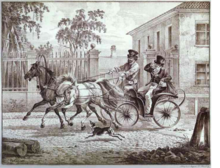Droshky



A droshky or drosky (Russian: дрожки (plural); Polish: dorożka (singular); Estonian: troska (singular)) is a term used for a four-wheeled open carriage used especially in Russia. The vehicle has a long bench on which the driver or passengers sit as if on a saddle, either astride or sideways.[1][2] From droga, the pole that connects the front and rear axles.
See also[edit]
References[edit]
Wikimedia Commons has media related to Droshky.
- ^ Webster, Noah (1907). Webster's International Dictionary of the English Language. George Bell & Sons. p. 457. OL 22896559M.
Dros'ky (drŏ'kў), n.; pl. droskies (-kĭz). [Russ. drojki, dim. of drogi a kind of carriage, prop. pl. of droga shaft or pole of a carriage.] A low, four-wheeled, open carriage, used in Russia, consisting of a kind of long, narrow bench, on which the passengers ride as on a saddle, with their feet reaching nearly to the ground. Other kinds of vehicles are now so called, esp. a kind of victoria drawn by one or two horses, and used as a public carriage in German cities. [Written also droitzschka, and droschke.]
- ^ Smith, D.J.M. (1988). A Dictionary of Horse Drawn Vehicles. pp. 68–69. ISBN 0851314686. OL 11597864M.
Droshky. Four-wheeled passenger carriage of Russian origins. Originally ridden by two or more persons seated on an upholstered cross-plank. The seating was eventually changed to a well-padded bench, but near to road level. Protected by a falling or half-hood. Drawn by three horses abreast, decorated with silver bells. The centre horse, between shafts and under a wooden arch or 'douga';did most of the hauling — at a smart trot, while the outer horses cantered, with outward turned heads, for show.
